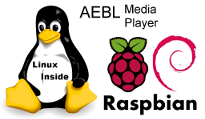As with the previous post, there continues to be a lot going on, so we'll keep this post limited to the new AEBL Virtual Machine and AEBL blades.
The AEBL Virtual Machine is a stand alone AEBL appliance that runs on a host computer, in order to take advantage of certain AEBL features, without having to dedicate another hardware device.
A blade is a plug in module which adds to the functionality of an AEBL appliance or Virtual Machine, allowing it to perform many additional features that enhance the mobile media experience, and even may delve away from media in some cases.
While AEBL is a relatively new application that takes advantage of new technology advancements, a lot of what underlies AEBL is decades old,
stemming back to the 1980's and earlier, pre-internet, specifically revolving around the early ARPANET and BBSs, with the core concept of enabling communication and sharing of knowledge.
There are, of course, two main aspects of this. The storage of information and the communication, or transfer, of that information. At its core, that is what AEBL does. It captures and stores and also allows the transfer, and subsequent display, of information.
What blades do, is enhance that capture, storage, transfer and display function. Whether it be through cloud (private and public) storage, NAS, remote mirroring, and other methods, connection to alternative networks, both public and private, to streaming media distribution or web sites and blogs, and administration of your AEBL appliance, AEBL's blades can be installed to perform these more enhanced functions. Some of the more advanced blades being worked on include home / office and device automation, with realtime and remote monitoring, to augmented and virtual reality, allowing for co-connected virtual worlds and immersion of natural and virtual worlds, and also parallel computing and autonomous systems design, development, and deployment, with black box and flow based computing capabilities, and the creation of private networks across dissimilar infrastructure. Blades can work independent of each other, or work together to enhance each other's functionalities and can be installed and turned on and off, as desired, without affecting the core of the AEBL appliance.
In order to help with development and also to allow people to take advantage of the AEBL system, we've created the AEBL Virtual Machine. It can be run on any computer that has the resources necessary to run the appliance, of course.
Using the freely available Virtual Box, which runs on any host operating system, an AEBL Virtual Machine can be run, without interfering with (aside from resource requirements) or risking harm to the host computer or files.
It was very important for us to provide the smallest package possible for people to download and as a result, the Virtual Machine is created similar to what one might expect from a computer purchased at the store. It needs to be unpackaged, using 7zip due to its high compression algorithms, making the 1.7GB file into a relatively small, 350MB package. Then, on first boot, it installs the necessary files to create a base AEBL system, before it is ready for use. So while it may take some time to make ready, it is similar to the user experience most people expect with a computing device.
The link to the AEBL Virtual Machine package is here, on dropbox:
https://www.dropbox.com/s/clidd488ag805x1/AEBL.vdi.7z?dl=0
In keeping with a stand alone AEBL appliance, it requires only 512MB of RAM to run and once installed, the virtual drive size will be approximately 2.5GB - 3.0GB, but can expand to 64GB, depending on the blades and files stored on the appliance. It also has the ability to allow for additional local or remote storage, as desired.
The readme.txt file for the AEBL Virtual Machine is located here:
https://github.com/krattai/AEBL/blob/master/AEBL%20Virtual%20Machine/readme.txt
Further information will be provided on the AEBL github wiki.
While AEBL is a functional appliance, used in high uptime and availability production environments, we still call it Beta and this may even be considered early Beta. The reason being that while some easy user interfaces are already available, some of the more core features still may require a bit of a "hands on" approach. Of course, that will change as blades, interfaces, and updates to the AEBL system are applied and provided. In the mean time, we will do everything we can to help make your AEBL experience as easy as possible. We also encourage and welcome others to help make AEBL the best it can be, considering that AEBL is a labour of love and an Open Source project, by providing beta test feedback and helping develop core, blades, interfaces, documentation, and even feature requests, as you are able.
Here's to wishing all of you the best in 2015 and we look forward to providing you with a fantastic media content and information storage and distribution tool, now and into the future.

No comments:
Post a Comment